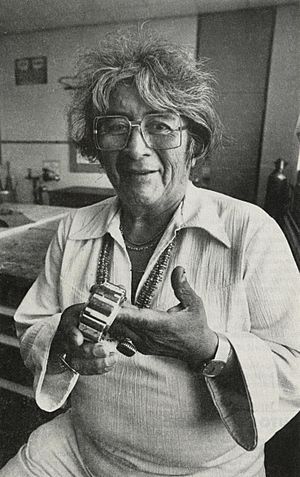Charles Loloma facts for kids
Quick facts for kids
Charles Loloma
|
|
|---|---|

Loloma in 1979
|
|
| Born | January 7, 1921 |
| Died | June 9, 1991 (aged 70) |
| Nationality | Hopi, American |
| Known for | Jewelry, Painting, Pottery, Sculpture |
| Spouse(s) | Otellie Loloma |
Charles Sequevya Loloma (born January 7, 1921, died June 9, 1991) was an amazing American artist. He was from the Hopi people, an Indigenous group. Charles Loloma became a very important Native American jeweler in the 1900s. He was famous for using materials like gold and special gemstones. These materials were not often used in Hopi jewelry before him.
Contents
Growing Up and Learning
Charles Loloma was born near Hotevilla. This is on the Hopi Third Mesa in Arizona. His parents were Rex and Rachel Loloma. He belonged to the Badger clan, which was his mother's family group.
He went to Phoenix Indian High School in Arizona. There, he started his art journey. He became a muralist and painter. A famous artist named Fred Kabotie asked him for help. They worked together to copy old murals from the Awatovi Ruins. These copies were for the Museum of Modern Art in New York. Later, Charles Loloma also helped with murals for the Golden Gate International Exposition in San Francisco in 1939.
Charles married Otellie Pasiyava. She was a Hopi potter. Charles served in the United States Army from 1942 to 1945. He was stationed in the Aleutian Islands. After the war, he used the GI Bill to go to college. In 1947, he attended Alfred University in New York. He and Otellie both studied pottery there. They learned new ways to make clay stronger. They also learned modern ways to shape and fire pottery. Their goal was to share these skills with the Hopi people. This would help the Hopi community become more self-sufficient.
Becoming a Famous Artist
In 1954, Charles Loloma opened his own pottery shop. It was in Scottsdale, Arizona. He called his pottery line "Lolomaware."
Even though he was good at pottery and painting, Charles found his true passion. It was making jewelry. Some of his jewelry designs were inspired by art from other cultures. This was new for Native American art. Some people didn't like it at first. They would say, "It's nice, but it's not Indian." His work was even turned away from the Gallup Inter-Tribal Ceremonial three times.
Unique Jewelry Style
Most jewelers in the Southwestern United States use materials like turquoise and silver. Charles Loloma was different. He used unusual materials. These included sugilite, lapis, ivory, gold, pearls, and even diamonds. He used turquoise, but often just as a small accent.
He got ideas from cultures all over the world. For example, he made Hopi versions of ancient Egyptian gods. His jewelry was shown at the first Heard Museum Fair in 1961. It was featured in many more shows after that.
Teaching and Innovating
In 1962, Lloyd Kiva New became the director of the Institute of American Indian Arts. This school is in Santa Fe. He asked Charles and Otellie Loloma to be teachers there. Charles became the head of the plastic arts department. After a few years, Charles went back to Hotevilla. He opened his own studio there. He also sold his jewelry at the Heard Museum Shop and other art galleries.
As his art grew, he tried new ways of making jewelry. He used a method called tufa casting. He also used inlay, which means setting stones into metal. He would use stones of different heights. He also put "inner gems" on the inside of his jewelry pieces. He believed that "people have inner gems." This is why he put them in his art.
Global Recognition
Charles Loloma achieved many great things around the world. He won first prize at the Scottsdale National Indian Art Exhibition seven years in a row. He had many art shows in Paris, France. He was featured on TV shows by NET and PBS in 1972. In 1974, he was an artist-in-residence in Japan. This means he lived and worked there for a time. He was also asked to make a special piece of jewelry for the queen of Denmark. He traveled to many countries, including France, Egypt, and Colombia. His success inspired other Native jewelers, like Jesse Monongye.
Charles Loloma's work was shown in a TV series. It was about American Indian artists for the Public Broadcasting System. Other artists in the series included R. C. Gorman and Helen Hardin.
Charles Loloma passed away in 1991. But he continues to inspire Native artists today. He once said, "We are a very serious people and have tried hard to elevate ourselves, but in order to create valid art you have to be true to your health and your heritage." When his biographer, Martha Hopkins Struever, asked him what he wanted to be remembered for, he said, "What I'd like to be known for is beauty." Interestingly, the name "Loloma" means "Beauty" in the Hopi language.

